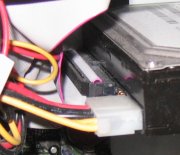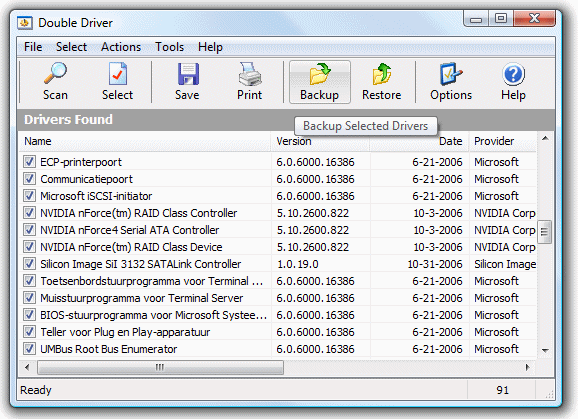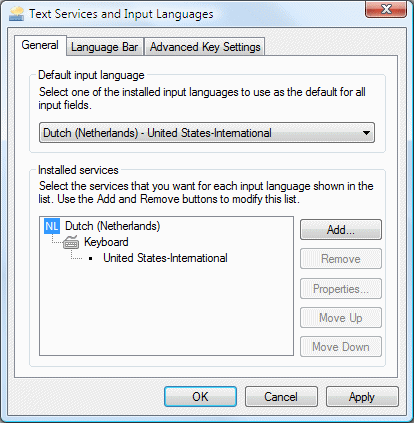

Reinstalling Windows is a time consuming job, where many even fear to do it. This is the reason why most keep messing around with a strongly messed up system while the accompanying annoyances are taken for granted. Do you recognize this situation? Then it's probably time to take some action to change the situation for the better because reinstalling and optimizing Windows has a big effect on the usability of the computer. When afterwards an image of the system is created, the time invested will be worth it!
This website describes from A to Z how to install and optimize Windows. This information is clearly summarized in 10 steps (with referrals to more specific information). Most tips in step 5 to 10 can be applied to an existing Windows-installatie as well.
Even for a specialist, reinstalling Windows is time consuming. It will take approximately 5 hours to set up Windows completely as desired. Installing Windows on itself is not that time consuming, but backing up the personal data, installing the updates, hard- and software, fine tuning of the settings, restoring the personal file and (if desired) creating an image of the system partition.
The advantages
But this can not be a reason not to reinstall Windows! A polluted operating
system (with all kinds of software and add-ons), can be very annoying. The funny
thing about this: in most cases you only realize that your computer was a real
mess after Windows is reinstalled. You won't be the first who postpone buying a
new computer.
By keeping the usability in mind at every step, will result in an optimized computer which was worth the investment. This will result in a computer which can be used problemfree for multiple years (probably the best proof of this approach: most of my customers of a reinstall of Windows only contact me, when they intend to buy a new computer). Besides these advantages, think of the learning effect of doing it!
Summarizing: reinstalling Windows is time consuming but very rewarding!
|
|
Probably the best to for a riskless reinstalling of Windows: replace the old hard disk with a new hard disk. By doing so, all (personal) data and settings will be 100% safe because they are still available on the old hard disk. The accompanying advantages are a faster computer (in most cases) and reinstalling Windows takes less time. A new hard disk doesn't cost that much and changing the hard disk can be done by yourself without any risk. Before buying the hard disk, check out what type of hard disk the computer already has because there are two different types: the old IDE and the new SATA connection. The type of motherboard will determine which type can be used.


IDE versus SATA connection
Because it is still possible to start the previous Windows installation from the old hard disk (by switching the hard disks back), the installation and optimization can be done over a longer time period. Because the risk of losing personal data is close to zero, it is safe to experiment on the new hard disk.
The installation of Windows is time consuming, and an error is quickly made. Before a critical action will be done (like changing the Windows settings or the installing of additional software) it is wise to image the system partition first to make sure the situation of that moment is saved. This will prevent that the reinstallation of Windows has to be done all over again when a problems arise.
The first step is saving the personal data. Think of all information which can't be recovered (easily) when they are no longer available, like the personal documents, music, videos, downloaded software, e-mail, contacts... (for storage locations, visit the page about creating a backup of the personal files). At reinstalling Windows, those files will be overwritten when the hard disk is partitioned and formatted. With the Windows Explorer, the personal files can be easily found and copied to a safe location (like an external hard disk or flash memory). When Windows is installed on a new hard disk, then this step can be skipped. When the hard disk is partitioned in multiple partitions, then the personal files are reasonably safe when they are stored on the non-Windows partition. However, for safety reasons it is better to save them on an external storage location as well. It is better to be safe then sorry...
Some personal data (like the Internet Explorer Favorites and RSS-feeds) are more difficult to find. Backup the received and send email and contacts (and possibly the calendar, task and notes) as well. The exact storage location depends on the used software. Most used email programs are Outlook Express (XP), Windows Mail (Vista) and Outlook (part of the Office Suite). For more extensive information visit the page about the storage location and how to backup the personal data.
TIP: If it is no longer possible to start Windows (to save the personal data) one can still access the hard disk with a bootable CD (like Bart's PE or VistaPE). When such a CD is not available, the hard disk can still be accessed by installing Windows on a new hard disk. By adding the old hard disk as second hard disk (as slave), the files can be accessed as well. The files on the hard disk can also be accessed by connecting the hard disk as slave on another computer.
Email account settings and passwords
Make sure you are able to restore the email account(s), Messenger account(s)
and FTP-account(s) settings (for uploading your website)
by writing down the settings (or creating a
screandump).
The passwords of these accounts can be viewed with special software (like those
of www.nirsoft.net). The tool IE View
(from NirSoft as well) even shows the passwords of visited websites.
Product code of Windows and Office
Both Windows and Office software use a product code to install the software. In
most cases, the product codes can be read from the license label
(pasted at the back or side of the computer and/or the installation CD/DVD
cover). Without this product code, it is not possible to reinstall the software.
If those product codes are not available, they can be restored from the Windows
system with the tool ProduKey (from NirSoft as well).
Make notes from the current settings
It can't hurt to make some notes of current settings, like those of the internet
connection and the different Windows features (like Windows Explorer,
Internet Explorer...) and other installed software.
Hardware drivers
The unknown hardware items in the Windows Device Manager are a frequently
returning problem after installing Windows (like the network adapters, the
modem, the graphics card, the soundcard, ...). By writing down the names of the
different devices in the Windows Device Manager, the drivers are easier
to find on the internet because you know what to look for. To prevent searching
the internet, it is even better to save the hardware drivers with the tool Double Driver
or DriverMax (in most cases the last gives the best results). When hardware is not recognized after the reinstallation of
Windows, they can be used when Windows asks for the drivers (by referring to the
location where the drivers have been stored).
TIP: Within Windows Vista, the Device Manager is directly available in the Control Panel. Within Windows XP, the Device Manager is available by the Control Panel, System, tab Hardware, button Device Manager.

Visit the page about saving the personal data, settings and drivers for more information about saving the hardware drivers.
In most cases the hard disk has not been split up in multiple partitions, but just one partition (the C: partition) with the Windows operating system, the installed software and all personal data. If additional partitions are not desired (for example to store an image of the system), then it is not necessary to repartition the hard disk: at the Windows setup the C: partition can be used immediately to reinstall Windows on. After (quickly) formatting this partition, all files on the partition will be deleted automatically!
The advantages of multiple partitions
By placing the personal data on a different partition (which separates them from
the operating system), the hard disk is more clearly arranged. An additional
partition can also be used for storing an image of the Windows partition (see step
10). Dividing the hard disk in multiple partitions makes it easier as well to
backup the personal files frequently with automated software like
SyncBack.
The ideal partition settings
Reserve a partition of 20-30 Gb (5-10 Gb minimal) for a Windows XP installation
and at least
40-50 Gb for a Windows Vista installation. The remaining space on the hard disk
can be used for other purposes, like a partition for personal data (the D:
partition, formatted with the NTFS file system). An additional partition of 20 to 30 Gb
(5-10 Gb minimal) (E: partition, formatted with the FAT32 file system) can
be used later on to store an image of
the Windows partition.
The picture below shows the Windows Disk Manager as an example of the 3 partitions:

When to partition?
Changing the partition settings can be done before running the Windows setup,
during the setup and afterwards:
PARTITIONING IN CASE OF A RECOVERY PROCEDURE?When the computer has a special recovery procedure, which is stored on a special (sometimes hidden) partition, repartitioning the hard disk is not always possible. Depending on the type of recovery procedure, the recovery won't work anymore after the partition is resized! An error message appears or the newly created partition(s) are overwritten automatically by a repartitioning done by the recovery software. When a resized partition is desired, it has to be done afterwards (which will 'disable' the recovery procedure until the old partition is restored). The page about resizing the Windows partition in case of a recovery partition discusses this subject in more detail. |
Formatting the Windows partition
The newly created partitions has to be formatted to give it the desired file
system. At Windows setup, the user is asked what file system to use, the NTFS
file system is prefered in most cases.
ATTENTION: At partitioning and formatting the hard disk, all files will be deleted! Backup your personal files before doing so!
Visit the pages about partitioning the hard disk and formatting partitions.
Copying the personal files to a safe location and the repartitioning is skipped by most users. In those cases the reinstallation of Windows starts with step 3: the Windows setup procedure. To prevent from troubles caused by missing drivers of connected hardware, disconnect the external hardware (like printers, scanners, ...) before the setup is started. After the setup has finished. the hardware can be connected one by one to install the drivers.
Default Windows installation versus a recovery procedure
Reinstalling Windows can be done by following two different procedures: the
default Windows installation with a Windows-CD (XP)/-DVD (Vista)
or the recovery procedure (in most cases started from the recovery partition)
which will bring the computer back to the factory settings. Although the default
installation offers the most flexibility, a recovery system has the advantage of
restoring the computer back to the factory settings (the installation of drivers,
software and settings included) with a few mouse clicks. But there are
disadvantages as well: the options are limited, unknown settings are applied and
unwanted (in most cases adware) software is installed on the computer.
Starting the computer from the CD/DVD (default installation)
The default Windows setup procedure is pretty simple: start the computer from
the Windows-CD/DVD and confirm (by pressing a key) the booting from the CD/DVD
when asked for and the setup will be started automatically. When the computer
won't start from the CD/DVD, the boot order has to be changed, which is done in
the BIOS. Depending on the type of motherboard, a specific key (F1, F2, F3, F10, F11, F12, DEL or INS)
has to be pressed at the startup of the computer. The next step is to search the
BIOS for an option called boot order, boot sequence or something similar and to
change the boot order to make sure the DVD-player is the first bootable medium
to start from.
The setup
The Windows setup can be walked through easily step by step. Select
installing and not the repairing of Windows. When asked for the partition to
install Windows on, don't forget to delete the existing partition to be able to
repartition the hard disk. When asked for an administrator password, it can be
left blank when a password is not needed.
PROBLEMS WITH PARTITIONS AT SETUPWhen the setup is not able to format the system partition (one of the most mentioned problems running the setup) verify that you didn't boot the installation CD/DVD within Windows. The computer has to be booted from the CD/DVD! When the setup is not able to find the hard disk? This is caused by the missing Windows drivers for a specific SATA-controller and/or a RAID-configuration (they are mostly available at the CD accompanying the motherboard and/or the website of the manufacturer). For Windows Vista, those drivers can be loaded at the moment the setup asks for the partition to install Windows on. For Windows XP, those drivers have to be loaded at the beginning of the setup by pressing the F6 key when asked for in the status bar at the bottom. |
The product code
At some point in the setup procedure, the product code is asked for. This code
is mentioned on the license sticker which is normally placed on the back or side
of the concerning computer. To get out of troubles, don't exchange this code
with other computers because this can cause issues when the installed Windows
versions has got to be activated (after Windows is working and connected to the
internet).
Keyboard and input language settings
At setup, the user is asked to select the desired keyboard and language
settings. When an international keyboard is used, select United
States-International. When the wrong keyboard settings have been chosen,
some keys won't result in the symbol they represent (in stead of the @ symbol, a
different symbol is displayed). It is no big problem if you did choose the wrong
keyboard, because these settings can be changed afterwards as well (Control
Panel, sub
Regional and Language Options, followed by the tab Languages, button Details
(XP) or tab Keyboards and Languages,
button Change keyboards (Vista).

Managing user accounts
At setup, multiple user accounts can be created, but it is advised to keep it by
one account with administrator privileges, to change the settings as desired and
to add the other accounts later on.
For the user account, a short name without spaces and special symbols is preferred. This will prevent the user from troubles when older software (which is not able to handle folders with such symbols) is used. The shown name of the user account can be changed later on at the sub User accounts in the Control Panel.
Browse this website for more information about the Windows XP-setup and the Windows Vista-setup.
REINSTALLING WINDOWS WITH A RECOVERY PROCEDUREFollow the manufacturers instructions when the computer has a recovery system. Some of the above tips are applicable for this procedure as well. In case of a recovery system there are four different procedures to restore Windows to the default settings:
|
Windows Update
After the first time Windows is started, it is wise to start the Windows-update
procedure immediately.
Windows Update is in both
Windows XP
and
Windows Vista available by the sub All programs in the Start Menu. In Windows XP,
select the custom installation and install both the essential Windows-updates
and the optional software and
hardware updates. Repeat this process until all updates are installed.
TIP: By choosing for Microsoft Update in stead of Windows Update, the updates for other installed Microsoft products (like the Office Suite) are installed as well. For Windows XP, Microsoft Update is available by the Windows Update page and for Windows Vista by the option Use Microsoft Update of the Windows Update Window.
Hardware drivers
Although there is a lots of hardware recognized automatically by Windows (and
Windows Update), some of the hardware drivers will still be missing. Most of
those drivers can be installed from the CD/DVD accompanying the hardware.
Although these drivers will do fine, it is better to download the most recent
directly from the manufacturers website.
Don't forget to install the motherboard drivers, else you will have problems with the sound and power management. To find out the type of motherboard, the tool CPU-Z (download: www.cpuid.com/cpuz.php) can be used. The website of the manufacturer will lead you to the latest available drivers. The tool PC Wizard (download: www.cpuid.com/pcwizard.php) can be very useful as well, especially for tracing the needed hardware drivers.
Visit the pages about the Windows XP-drivers and Windows Vista-drivers for more specific information.
Installing and optimizing Windows in 10 steps part II
© 2001-2022 - Menno Schoone - SchoonePC - Rotterdam - The Netherlands